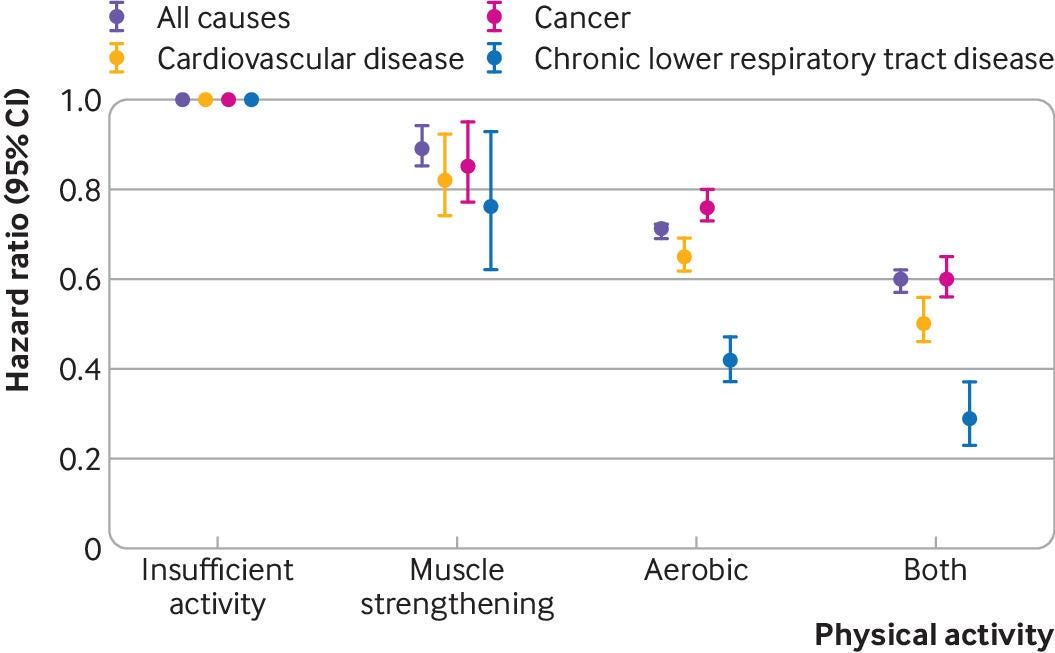Newsletter 109: Preventive health: learning the basics through community building
A few months ago, I embarked on a small, personal experiment with a group of friends. As someone who's been committed to regular exercise for most of my life, recent events prompted me to reassess the effectiveness and direction of my efforts.
Firstly, my grandfather received a dual diagnosis of bone cancer and dementia.
Secondly, my father suffered a stroke.
Thirdly, I discovered the concept of VO2 max, which led to the realization that my cardiovascular fitness was subpar despite years of training.
These developments led to the following question:
What proactive steps could I take today to boost my efforts and potentially prevent the health issues my family was encountering?
One strategy that has consistently proven effective in my life is public accountability. Often, when I aim to achieve a goal, I openly share it with as many people as possible. Subsequently, whenever we meet, they inquire about my progress. This approach makes abandoning projects much more challenging when motivation fades away.
Motivated by these reflections, I initiated a small group comprising individuals committed to leading healthier lives. We welcome anyone interested in preventive health, bio-hacking, or simply becoming more active. The group's purpose was to function as both a knowledge hub and an accountability circle.
Four months into this journey, I've gained so many insights into the science of exercise, nutrition, sleep, and various other health-related topics. This learning experience was enriched by the opportunity to meet and exchange ideas with many great people in Singapore and abroad!
Today, I wanted to share some of the most impactful lessons I've learned thus far. All the content below has been shared and discussed in the community, offering a glimpse into the topics we typically talk about:
Step by Step: Revealing the Surprising Impact of Walking on Health
A recently published study on the link between daily step counts and overall cardiovascular mortality struck a chord. This study examined data from 17 research papers involving 226,889 participants.
Here are the core findings:
Each 1,000-step increase per day results in a 15% reduced risk of all-cause mortality.
A 500-step daily increment correlates with a 7% lower risk of CV mortality.
Health benefits may begin with as few as 2,500 to 4,000 steps/day, challenging traditional definitions of a sedentary lifestyle and suggesting the more steps the better.
The benefits seem to plateau around 20,000 steps per day.
Maximizing Lifespan: The Dual Power of Cardio and Strength Training
A study from The BMJ explored the impact of adhering to physical activity guidelines on mortality, revealing that:
Out of 479,856 adults studied over 8.75 years, those engaging in recommended muscle-strengthening and aerobic activities had significantly lower all-cause mortality rates.
An 11% reduction in death risk was associated with muscle-strengthening activities, a 29% reduction with aerobic activities, and a 40% reduction when both activities were combined.
These findings suggest that meeting the physical activity guidelines can offer substantial protection against death from various diseases, including heart disease, cancer, and respiratory conditions.
Short Bursts of Activity: A Simple Strategy for Better Blood Sugar Control
These small bits of physical activity can lower glucose levels.
This study reveals the surprising benefits of brief, intermittent physical activity throughout the day. Participants who incorporated short, 2-minute walks every 30 minutes experienced more significant reductions in glucose and insulin levels compared to those who engaged in a single, continuous 30-minute walk. This pattern of activity proved more effective in managing postprandial blood sugar levels, even when the total walking time was the same.
The key takeaway?
Incorporating small bursts of any physical activity, whether it's walking, push-ups, or climbing stairs, into your daily routine can be more beneficial for blood sugar management than a single, longer exercise session. This approach offers flexibility, allowing you to tailor your activity to fit your schedule and lifestyle.
Strength Over Time: The Vital Role of Weight Training in Aging Gracefully
Muscle mass decreases by approximately 3-8% every decade after age 30, and this decline accelerates after age 60.
Doing weight training a few times a week is seen as an investment in long-term health, offering mobility, strength, and brain health benefits.
It is important to take care of your body to avoid future regrets and irreversible consequences.
Turning Back Time: How High-Intensity Interval Training Can Reduce Biological Age
In this randomized controlled trial, four weeks of high-intensity interval training reduced a marker of biological age by almost four years in a group of middle-aged adults.
What was studied?
The effect of high-intensity interval training (HIIT) on estimated biological age was measured using a “transcriptomic clock” based on messenger RNA. Messenger RNA is a class of biomolecules responsible for translating DNA into proteins.
The secondary study outcomes included self-perceived stress, sleep quality, depression symptoms, BMI, fat mass, visceral fat area, skeletal muscle mass, waist-to-hip ratio, blood pressure, and resting heart rate.
Measuring VO2 Max Affordably
Understanding VO2 Max: The Benchmark of Aerobic Fitness
VO2 max, or maximal oxygen consumption, is crucial for assessing aerobic fitness. It's the highest amount of oxygen your body can use during intense exercise, expressed as oxygen consumption per unit of time, adjusted for body mass. Typically measured in a lab setting using a treadmill or cycle ergometer, VO2 max reflects an individual's fitness level and cardiovascular health and can be influenced by factors like age, gender, and fitness training.
Traditional Measurement Methods: Accurate but Often Costly
The gold standard for measuring VO2 max is a lab-based graded exercise test. However, this method can be expensive and inaccessible for many (given that you must do it several times a year). Some modern fitness trackers and smartwatches offer estimations of VO2 max using heart rate data, providing a more accessible albeit less precise alternative.
I personally did a clinical test after completing my first half-marathon!
Affordable Alternative: The Cooper Test
For a budget-friendly and surprisingly accurate method, consider the Cooper test. Devised in 1968 by Kenneth H. Cooper for the US military, this simple yet effective test involves running as far as possible within 12 minutes. The distance covered is then used to estimate your VO2 max based on your age and gender.
How to Conduct the Cooper Test
All you need is a stopwatch and a measured track. During the 12-minute test, aim to cover as much ground as possible – walking is allowed, but a continuous, intense effort yields the best results. Afterward, calculate your VO2 max with this formula: VO2 max = (22.35 x distance in kilometers) – 11.29 or this calculator.
Community Engagement
We organized a community competition where participants took the Cooper test. Everyone used devices like Garmin or Apple Watches to track and compare results, turning the exercise into a fun and competitive activity. This not only fostered community spirit but also allowed members to gauge their fitness levels affordably and effectively.
Exercise and Sleep: The Balancing Act for Long-Term Cognitive Health
If you exercise at the expense of sleep, this one is for you...
If you're sacrificing sleep for exercise, you might want to reconsider. A study analyzing data from approximately 9,000 individuals aged 50–95 years revealed that while regular exercise contributes to better cognitive performance, this benefit is significantly undermined by insufficient sleep.
Specifically, individuals who engaged in frequent, high-intensity physical activity but slept less than 6 hours per night experienced a faster decline in cognitive health over 10 years compared to those who slept poorly but exercised less.
This suggests that while exercise is beneficial, optimal sleep is crucial in preserving long-term cognitive health. The study highlights the importance of balancing physical activity and adequate sleep to maintain cognitive function as we age.
Rethinking Protein Intake: Beyond the 20-Gram Myth Post-Workout
A new study challenges the long-held belief that the body can only utilize 20 grams of protein in one sitting, particularly after a workout. Researchers tested this by having individuals engage in exercise, followed by consuming either no protein, 25 grams, or 100 grams.
The results showed that consuming 100 grams of protein significantly enhanced protein synthesis - the body's ability to use protein - even more than 12 hours post-consumption, compared to 25 grams.
This finding suggests that the body can indeed process and benefit from higher protein amounts after resistance training. It also indicates that the total daily protein intake is more critical for achieving fitness goals than the number of meals it's divided into. However, it's important to note that the study's implications for long-term muscle growth and responses to different protein types are still unknown.
The study used milk protein, known for being slow-digesting, leaving open questions about other protein sources.
Superfood Spotlight: The Wide-Ranging Health Benefits of Chia Seeds
Chia seeds are a powerhouse of nutrition and offer multiple health benefits, making them a great addition to your daily diet. Their high content of fiber, antioxidants, minerals, and omega-3 fatty acids contributes to various health improvements. Key benefits include:
Heart Health: Chia seeds can lower blood pressure and reduce heart disease risk due to their polyunsaturated fats, fiber, and anti-inflammatory properties.
Bone Health: They are a rich source of bone-benefiting minerals like calcium, magnesium, and phosphorus.
Blood Sugar Management: The seeds help maintain stable blood sugar levels, reducing the risk of metabolic syndrome and type 2 diabetes, thanks to their high fiber content.
Weight Management: Their protein and fiber richness aids in weight loss by promoting a sense of fullness and reducing food intake.
Antioxidant Properties: As a source of antioxidants, chia seeds can lower the risk of various health issues, including heart disease, cognitive decline, and certain cancers.
Nutrient Density: They provide essential omega-3 fatty acids, plant-based protein, and various micronutrients, making them a nutrient-dense food choice.
Incorporating chia seeds into your diet can significantly benefit your overall health due to their comprehensive nutritional profile and health-promoting properties.
As I continue to explore various health topics, I'm increasingly aware of how much there is to learn. However, a few key themes consistently emerge through our discussions here at Thrive and in the studies we've examined.
One of the most evident is the importance of exercise, a topic extensively studied and universally acknowledged for its numerous benefits, particularly maintaining movement and muscle mass.
Yet, it's crucial to understand that these benefits should not come at the cost of other vital elements like adequate sleep and nutritious meals. Recently, a few doctors practicing health prevention and longevity space have joined the community. I am grateful for their guidance, especially when we navigate complex topics such as supplements and bio-hacking.
My learning journey has been quite rewarding, in just a few months I learned more than in the past 30 years of my life!
I'm excited to apply these learnings to my health goals for 2024 and beyond, embracing a more informed and holistic well-being approach.
If you want to join the community, use the button below. If you are unsure if it’s a good fit, read this one.













